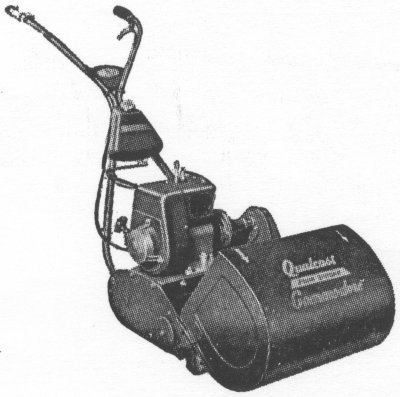MP084: Qualcast Commodore
The Qualcast Commodore was a popular motor mower from the 1960s for the home (domestic) user. The design was similar to many other machines of the period, especially models from companies such as Atco and Suffolk. In fact by this time these three companies were all part of the same group and there was some sharing of components across the ranges of the different manufacturers. For example, the Commodore was powered by the same Suffolk 75G four stroke engine that had been used on Suffolk's own machines for many years and was also supplied with Atco mowers. The Suffolk engine was reputed to be very economical and the company's own advertising claimed that it used less than one pint of fuel each hour.
The Commodore was introduced in 1957 as a replacement for the Royal Blade which was itself derived from the first Qualcast Motor Mower of the 1930s. Although there was a progression in the design of these machines the Commodore was clearly a "modern" mower. It was more compact and the overall design was sleeker than the preceding models which were based on even earlier machines. An updated version was introduced in 1964 and final model entered service in 1967. In 1968 the 14" Commodore was selling for £33-6-6. Qualcast produced a completely different machine with the same name in the 1980s.
One modern feature of the Commodore was the inclusion of a self-contained recoil rope start mechanism. The first motor mower had starting handles. Later models had kick starts but rope start was only introduced in the 1950s (at least for ordinary mowers) and by the end of that decade had largely superseded the earlier methods of starting. It was generally considered to be more reliable and easier to use than either a handle or kick start.
Another interesting feature of the Commodore was its clutch. This was activated by squeezing the lever to engage drive. Most earlier machines had a lever which needed to be released to engage the drive. The advantage of the Commodore's mechanism was that if the operator wanted to stop the mower they simply released the lever, which was much safer than having to positively activate a lever as on earlier machines.
The Commodore incorporated self-aligning ball bearings on the cutting cylinder. These helped achieve an accurate cut by ensuring the cutting cylinder was able to move slightly and maintain the correct contact with the bottom or fixed blade.
The Commodore is by no means the rarest mower but is nevertheless held in great affection by many enthusiasts.

